AMD Zen 3 Ryzen Deep Dive Review: 5950X, 5900X, 5800X and 5600X Tested
by Dr. Ian Cutress on November 5, 2020 9:01 AM ESTCPU Tests: Rendering
Rendering tests, compared to others, are often a little more simple to digest and automate. All the tests put out some sort of score or time, usually in an obtainable way that makes it fairly easy to extract. These tests are some of the most strenuous in our list, due to the highly threaded nature of rendering and ray-tracing, and can draw a lot of power. If a system is not properly configured to deal with the thermal requirements of the processor, the rendering benchmarks is where it would show most easily as the frequency drops over a sustained period of time. Most benchmarks in this case are re-run several times, and the key to this is having an appropriate idle/wait time between benchmarks to allow for temperatures to normalize from the last test.
Blender 2.83 LTS: Link
One of the popular tools for rendering is Blender, with it being a public open source project that anyone in the animation industry can get involved in. This extends to conferences, use in films and VR, with a dedicated Blender Institute, and everything you might expect from a professional software package (except perhaps a professional grade support package). With it being open-source, studios can customize it in as many ways as they need to get the results they require. It ends up being a big optimization target for both Intel and AMD in this regard.
For benchmarking purposes, we fell back to one rendering a frame from a detailed project. Most reviews, as we have done in the past, focus on one of the classic Blender renders, known as BMW_27. It can take anywhere from a few minutes to almost an hour on a regular system. However now that Blender has moved onto a Long Term Support model (LTS) with the latest 2.83 release, we decided to go for something different.
We use this scene, called PartyTug at 6AM by Ian Hubert, which is the official image of Blender 2.83. It is 44.3 MB in size, and uses some of the more modern compute properties of Blender. As it is more complex than the BMW scene, but uses different aspects of the compute model, time to process is roughly similar to before. We loop the scene for at least 10 minutes, taking the average time of the completions taken. Blender offers a command-line tool for batch commands, and we redirect the output into a text file.
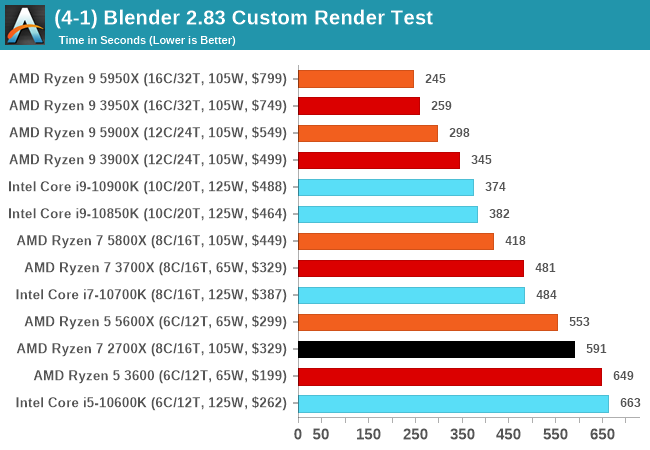
Corona 1.3: Link
Corona is billed as a popular high-performance photorealistic rendering engine for 3ds Max, with development for Cinema 4D support as well. In order to promote the software, the developers produced a downloadable benchmark on the 1.3 version of the software, with a ray-traced scene involving a military vehicle and a lot of foliage. The software does multiple passes, calculating the scene, geometry, preconditioning and rendering, with performance measured in the time to finish the benchmark (the official metric used on their website) or in rays per second (the metric we use to offer a more linear scale).
The standard benchmark provided by Corona is interface driven: the scene is calculated and displayed in front of the user, with the ability to upload the result to their online database. We got in contact with the developers, who provided us with a non-interface version that allowed for command-line entry and retrieval of the results very easily. We loop around the benchmark five times, waiting 60 seconds between each, and taking an overall average. The time to run this benchmark can be around 10 minutes on a Core i9, up to over an hour on a quad-core 2014 AMD processor or dual-core Pentium.
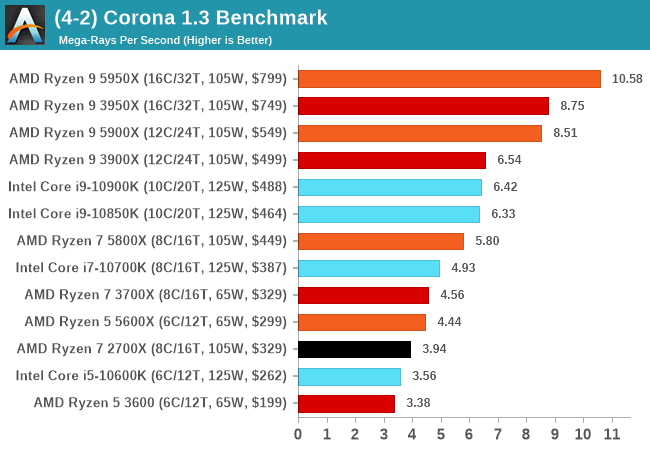
Crysis CPU-Only Gameplay
One of the most oft used memes in computer gaming is ‘Can It Run Crysis?’. The original 2007 game, built in the Crytek engine by Crytek, was heralded as a computationally complex title for the hardware at the time and several years after, suggesting that a user needed graphics hardware from the future in order to run it. Fast forward over a decade, and the game runs fairly easily on modern GPUs.
But can we also apply the same concept to pure CPU rendering? Can a CPU, on its own, render Crysis? Since 64 core processors entered the market, one can dream. So we built a benchmark to see whether the hardware can.
For this test, we’re running Crysis’ own GPU benchmark, but in CPU render mode. This is a 2000 frame test, with medium and low settings.
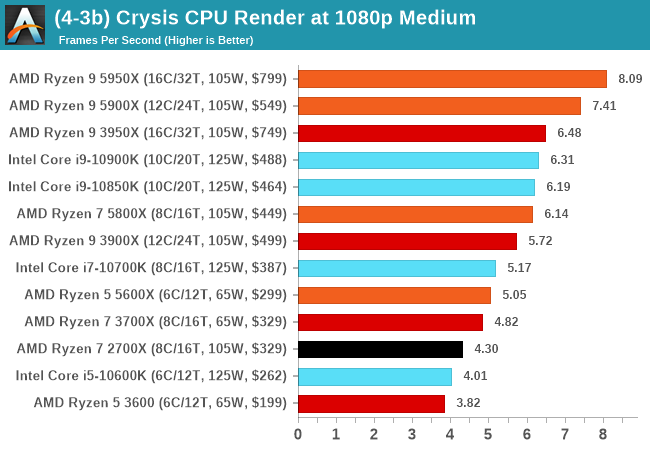
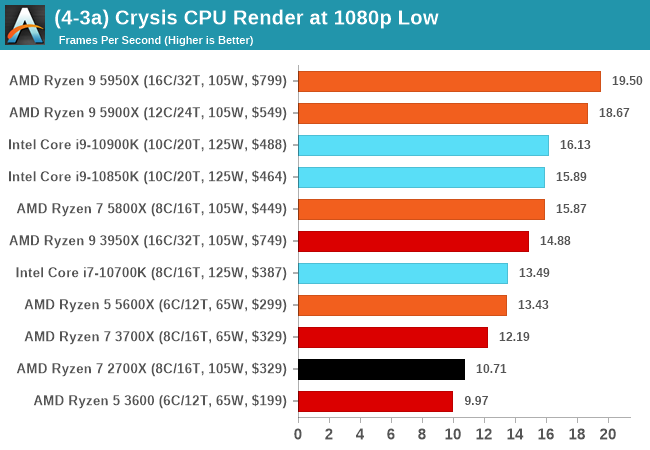
POV-Ray 3.7.1: Link
A long time benchmark staple, POV-Ray is another rendering program that is well known to load up every single thread in a system, regardless of cache and memory levels. After a long period of POV-Ray 3.7 being the latest official release, when AMD launched Ryzen the POV-Ray codebase suddenly saw a range of activity from both AMD and Intel, knowing that the software (with the built-in benchmark) would be an optimization tool for the hardware.
We had to stick a flag in the sand when it came to selecting the version that was fair to both AMD and Intel, and still relevant to end-users. Version 3.7.1 fixes a significant bug in the early 2017 code that was advised against in both Intel and AMD manuals regarding to write-after-read, leading to a nice performance boost.
The benchmark can take over 20 minutes on a slow system with few cores, or around a minute or two on a fast system, or seconds with a dual high-core count EPYC. Because POV-Ray draws a large amount of power and current, it is important to make sure the cooling is sufficient here and the system stays in its high-power state. Using a motherboard with a poor power-delivery and low airflow could create an issue that won’t be obvious in some CPU positioning if the power limit only causes a 100 MHz drop as it changes P-states.
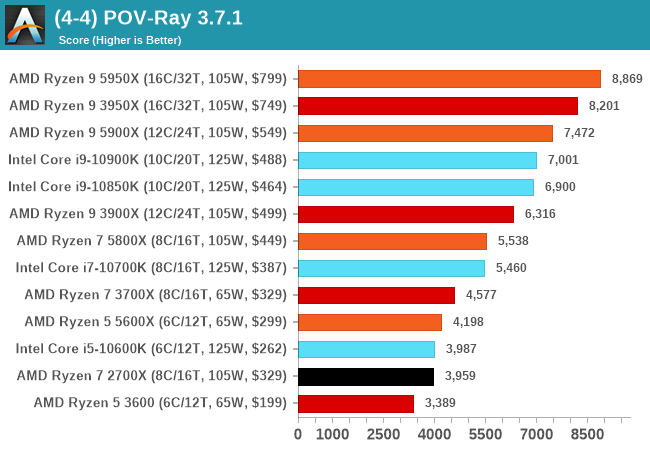
V-Ray: Link
We have a couple of renderers and ray tracers in our suite already, however V-Ray’s benchmark came through for a requested benchmark enough for us to roll it into our suite. Built by ChaosGroup, V-Ray is a 3D rendering package compatible with a number of popular commercial imaging applications, such as 3ds Max, Maya, Undreal, Cinema 4D, and Blender.
We run the standard standalone benchmark application, but in an automated fashion to pull out the result in the form of kilosamples/second. We run the test six times and take an average of the valid results.
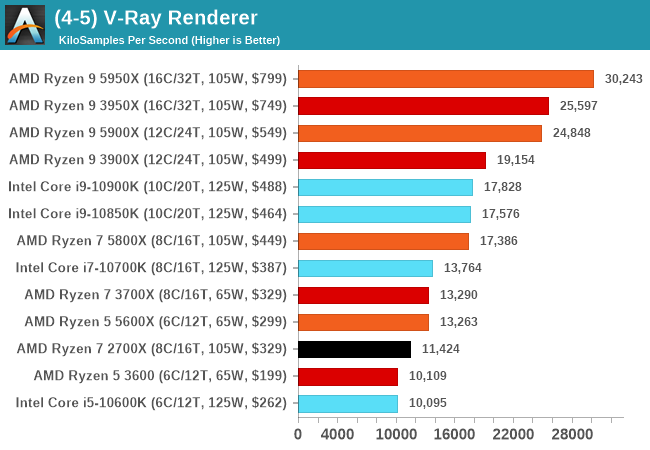
Cinebench R20: Link
Another common stable of a benchmark suite is Cinebench. Based on Cinema4D, Cinebench is a purpose built benchmark machine that renders a scene with both single and multi-threaded options. The scene is identical in both cases. The R20 version means that it targets Cinema 4D R20, a slightly older version of the software which is currently on version R21. Cinebench R20 was launched given that the R15 version had been out a long time, and despite the difference between the benchmark and the latest version of the software on which it is based, Cinebench results are often quoted a lot in marketing materials.
Results for Cinebench R20 are not comparable to R15 or older, because both the scene being used is different, but also the updates in the code path. The results are output as a score from the software, which is directly proportional to the time taken. Using the benchmark flags for single CPU and multi-CPU workloads, we run the software from the command line which opens the test, runs it, and dumps the result into the console which is redirected to a text file. The test is repeated for a minimum of 10 minutes for both ST and MT, and then the runs averaged.
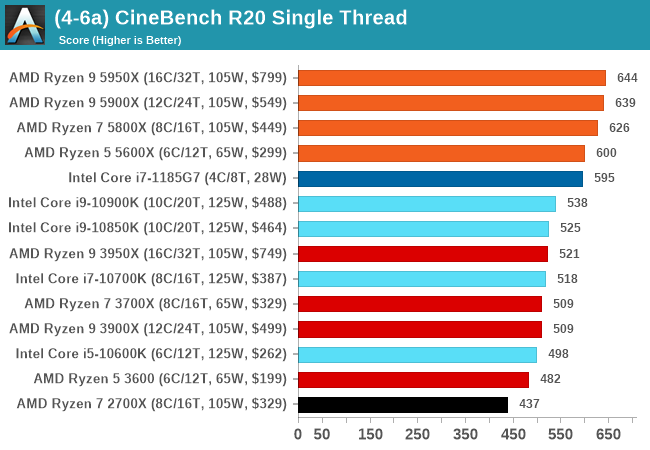
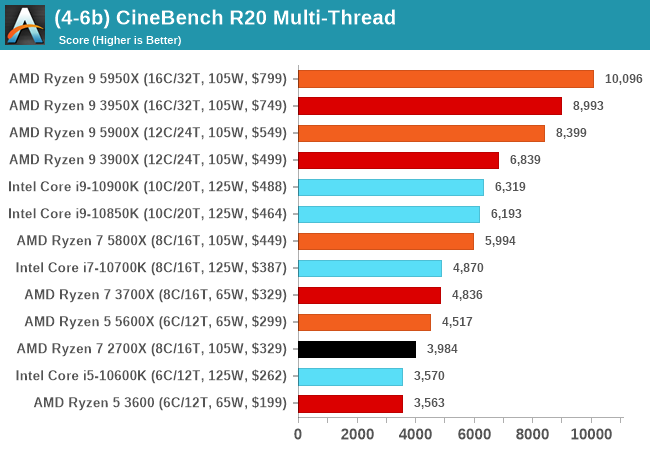



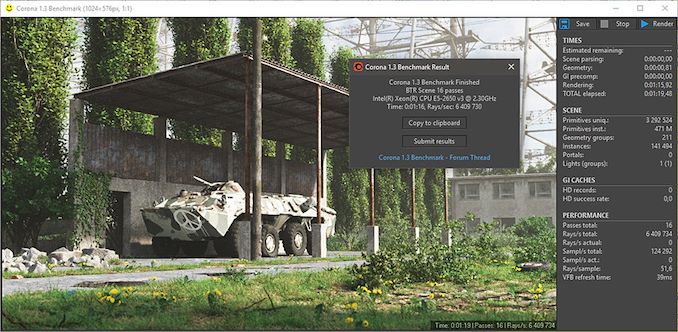
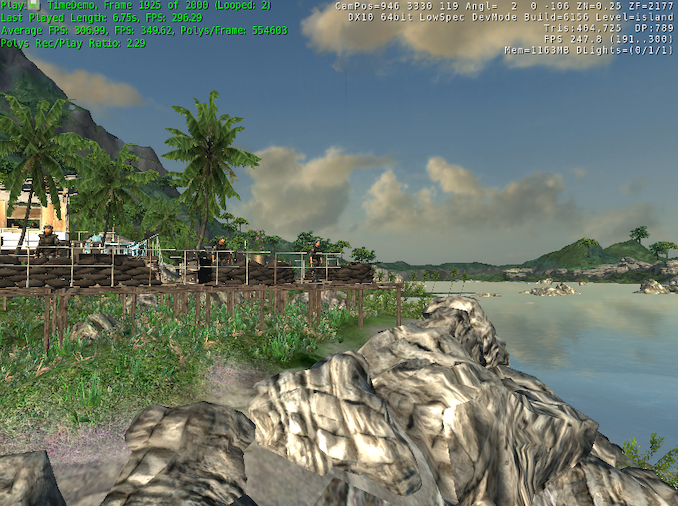











339 Comments
View All Comments
halcyon - Tuesday, November 10, 2020 - link
1. Ryzen 9 5xxx series dominate most gaming benhmarks in CPU bound games up to 720p2. However at 1440P/4K Intel, esp. 10850K pull ahead.
Can somebody explain this anomaly? As Games become more GPU bound at higher res, why does Intel pull ahead (with worse single/multi-thread CPU perf)? Is it a bandwidth/latency issue? If so, where exactly (RAM? L3? somewhere else)? Can't be PCIe, can it?
feka1ity - Saturday, November 14, 2020 - link
RAM. anandtech uses shitty ram for intel systemsMakste - Monday, November 16, 2020 - link
I think the game optimizations for intel processors become clear at those resolutions. AMD has been a none factor in gaming for so long. These games have been developed on and mostly optimised to work better on intel machinesSilma - Wednesday, November 11, 2020 - link
At 4K, the 3700X beats the 5600X quite often.Samus - Friday, November 13, 2020 - link
Considering Intel just released a new generation of CPU's, it's astonishing at their current IPC generation-over-generation trajectory, it will take them two more generations to surpass Zen 3. That's almost 2 years.Wow.
ssshenoy - Tuesday, December 15, 2020 - link
I dont think this article compares the latest generation from Intel - the Willow Cove core in Tiger lake which is launched only for notebooks. The comparison here seems to be with the ancient Skylake generation on 14 nm.abufrejoval - Friday, November 13, 2020 - link
Got my Ryzen 7 5800X on a new Aorus X570 mainboard and finally working, too.It turbos to 4850MHz without any overclocking, so I'd hazard 150MHz "bonus" are pretty much the default across the line.
At the wall plug 210 Watts was the biggest load I observed for pure CPU loads. HWinfo never reporting anything in excess of 120 Watts on the CPU from internal sensors.
"finally working": I want ECC with this rig, because I am aiming for 64GB or even 128GB RAM and 24x7 operation. Ordered DDR4-3200 ECC modules from Kingston to go with the board. Those seem a little slow coming so I tried to make do with pilfering some DIMMs from other systems, that could be shut down for a moment. DDR4-2133 ECC and DDR4-2400 ECC modules where candidates, but wouldn't boot...
Both were 2Rx4, dual rank, nibble not byte organized modules, unbuffered and unregistered but not the byte organized DIMMs that the Gigabyte documentation seeemd to prescribe... Asus, MSI and ASrock don't list such constraints, but I had to go with availability...
I like to think of RAM as RAM, it may be slower or faster, but it shouldn't be tied to one specific system, right?
So while I await the DDR4-3200 ECC 32GB modules to arrive, I got myself some DDR4-4000 R1x8 (no ECC, 8GB) DIMMs to fill the gap: But would that X570 mainboard, which might have been laying on shelves for months actually boot a Ryzen 5000?
No, it wouldn't.
But yes, it would update the BIOS via Q-Flash Plus-what-shall-we-call-it and then, yes, it did indeed recognize both the CPU and those R1x8 DIMMs just fine after the update.
I haven't yet tried those R2x4 modules again, because I am still exploring the bandwidth high-end, but I want to report just how much I am impressed by the compatibility of the AM4 platform, fully aware that Zen 3 will be the last generation in this "sprint".
I vividly remember how I had to get Skylake CPUs in order to get various mainboard ready for Kaby Lake...
I have been using AMD x86 CPUs from 80486DX4. I owned every iteration of K6-II and K6-III, omitted all Slot-A variants, got back with socket-A, 754, 939, went single, quad, and hexa (Phenom II x4+x6), omitted Bulldozer, but did almost every APU but between Kaveri and Zen 3, AMD simply wasn't compelling enough.
I would have gotten a Ryzen 9 5950x, if it had been available. But I count myself lucky for the moment to have snatched a Ryzen 7 5800X: It sure doesn't disappoint.
AMD a toast! You have done very well indeed and you can count me impressed!
Of course I'll nag about missing SVE/MKTME support day after tomorrow, but in the mean-time, please accept my gratitude.
feka1ity - Saturday, November 14, 2020 - link
Interesting, my default 9700k with 1080ti does 225fps avg - Borderlands 3, 360p, very low settings and anantech testers poop 175fps avg with 10900k and 2080ti?!? And this favoritize amede products. Fake stuff, sorry.Spunjji - Monday, November 16, 2020 - link
"Fake stuff"Thanks for labelling your post
feka1ity - Monday, November 16, 2020 - link
Fake stuff is not a label, it's a epicrisis. Go render stuff, spunji